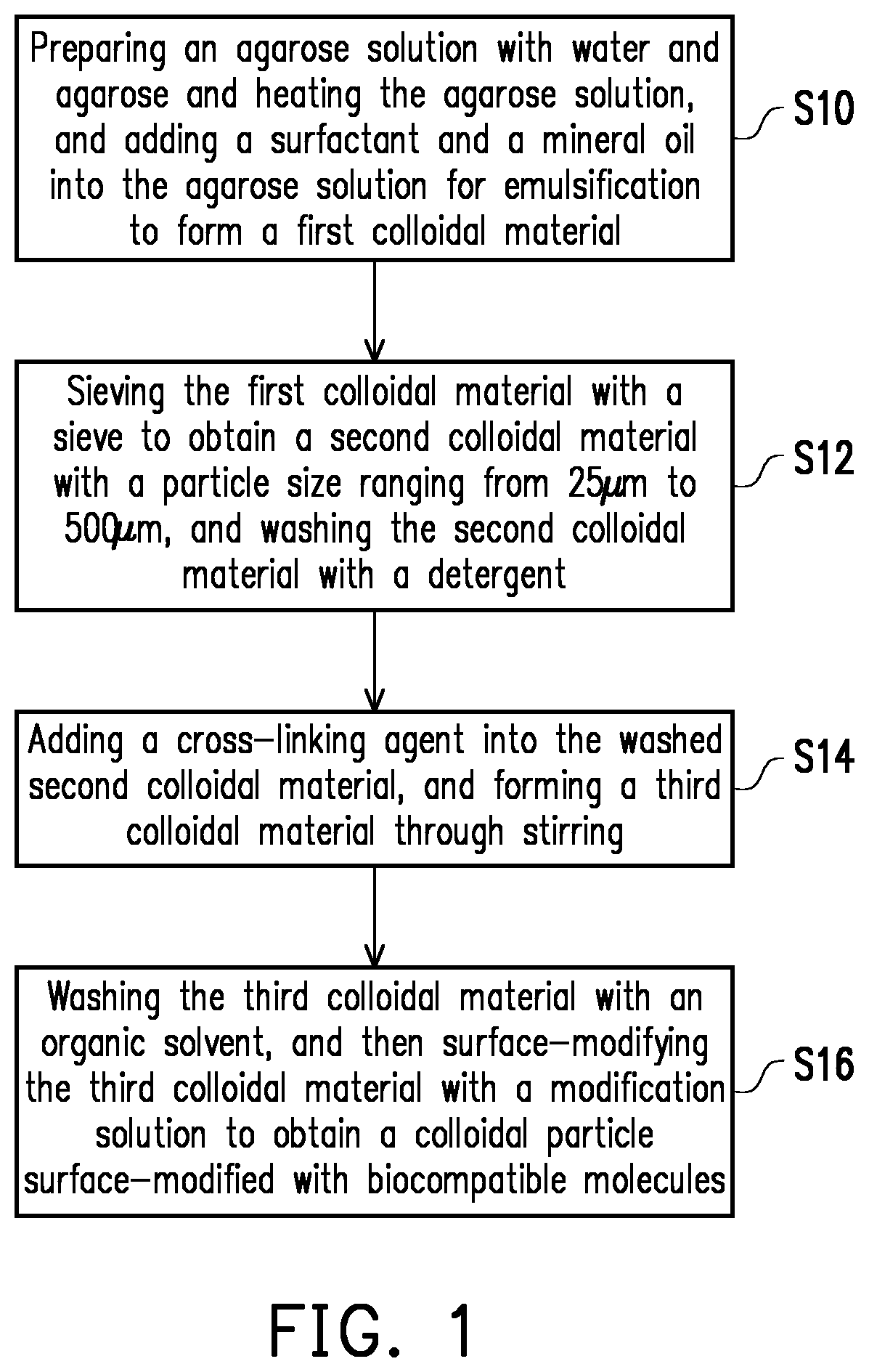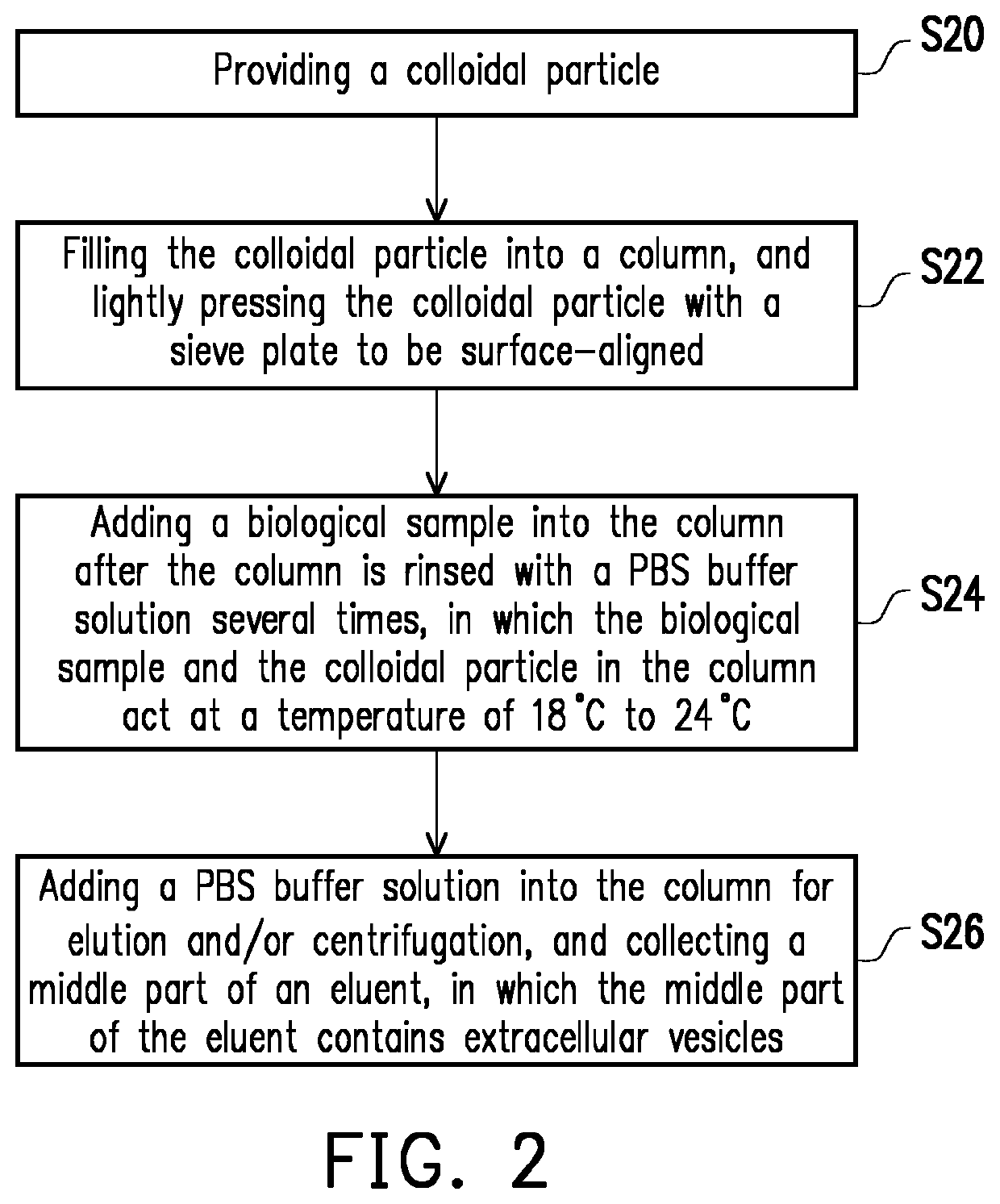Extracellular vesicle separation method, colloidal particle and preparation method thereof
a technology of colloidal particles and separation methods, which is applied in the field of separation methods, colloidal particles and preparation methods of extracellular vesicles, can solve the problems of low recovery rate, time saving, and none of them meet the requirements of high recovery rate, time saving, and high purity at the same time. , the effect of high recovery
- Summary
- Abstract
- Description
- Claims
- Application Information
AI Technical Summary
Benefits of technology
Problems solved by technology
Method used
Image
Examples
experimental example
[0039]In order to prove that the colloidal particle of the disclosure effectively separates extracellular vesicles, the following Experimental Examples are particularly provided.
experimental example 1
idal Particle
[0040](1) Preparation of an Agarose Particle
[0041]80 ml of water was mixed with 4.8 g of agarose, heated in a microwave oven or an autoclave, and heated at 90° C. for 2 hours for completely dissolved, so as to prepare a 6% agarose solution. Then, 13.5 ml of Span 80, 1.5 ml of Triton X-100, and 85 ml of a mineral oil were mixed evenly and heated to 95° C., then the 6% agarose solution was added thereinto for 30 minutes for emulsification. After the reaction was completed, the reaction temperature was lowered to room temperature. Afterwards, oil stains were washed off with a 1% SDS aqueous solution, and an agarose particle at 74 μm to 250 μm was collected through filtration. The particle was washed with 100 ml of n-hexane and 80 ml of 20% alcohol three times, and then was washed with 80 ml of double distilled water three times. 40 ml of 6% agarose particle (equivalent to the above-mentioned second colloidal material) at 74 μm to 250 μm were obtained.
[0042](2) Cross-Linkin...
experimental example 2
Purification of Cancer Cell Culture Medium
[0046](1) Filling Chromatography Column
[0047]A bottom of a column with a diameter of 8 mm, a length of 70 mm, and a total volume of about 3.5 ml was placed into a sieve plate, and was first rinsed with a PBS buffer solution. Then, the colloidal particle synthesized in Experimental Example 1 was drawn up and filled into the column with a dropper. After the colloidal particle sank to the height (70 mm) to be filled, the surface was aligned using the sieve plate to complete the colloid particle filling, and then the column was eluted with 10 ml of a PBS buffer solution to be balanced.
[0048](2) Extracellular Vesicle Separation
[0049]100 μl of a culture medium of cell line SKBr3 of human breast cancer cells was injected from the top of the column. When the fluid level dropped to or below the sieve plate, the sample injection was completed. The sample was eluted with a PBS buffer solution, and the early, the middle, and the late parts of the eluent...
PUM
| Property | Measurement | Unit |
|---|---|---|
| Temperature | aaaaa | aaaaa |
| Temperature | aaaaa | aaaaa |
| Temperature | aaaaa | aaaaa |
Abstract
Description
Claims
Application Information
 Login to View More
Login to View More - R&D
- Intellectual Property
- Life Sciences
- Materials
- Tech Scout
- Unparalleled Data Quality
- Higher Quality Content
- 60% Fewer Hallucinations
Browse by: Latest US Patents, China's latest patents, Technical Efficacy Thesaurus, Application Domain, Technology Topic, Popular Technical Reports.
© 2025 PatSnap. All rights reserved.Legal|Privacy policy|Modern Slavery Act Transparency Statement|Sitemap|About US| Contact US: help@patsnap.com



